History
Our family, the Gaunts, have been weaving wool cloth for generations. So when we sadly sold our family textile business in 2008, I thought it would mean the end of my weaving career and the end of the family’s connection with looms and the craft of weaving. It is alleged that our family came across from Ghent in the 12th century with the Flemish weavers, they were invited here by Henry I to bring across their skills and apply them to the important English wool crop and thus improve the economy that had been sapped by war. So, with at least 800 years of weaving in our blood, there was a strong urge to keep alive the tradition and retain that long relationship we had with the loom
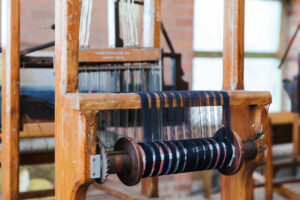
Since I left Leeds University in the 1980’s, the way textiles was being taught at universities and colleges has changed beyond recognition. The textile departments have had to reduce in size and adapt to serving a reduced manufacturing base here in the UK. The arrival of digital technology had meant that over the years the institutions had got rid of most of the old machinery that my, and previous generations, had learnt their skills on. And of particular interest to me, were the rows and rows of handlooms that we all slaved away on, struggling as students, to get to grips with the intricacies of designing cloth and the working parts of a loom; drafts and peg plans, cloth setts and all the rest of the skills a practiced weaver needs to master.
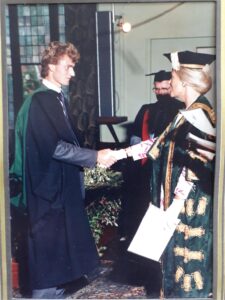
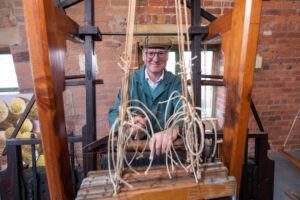
So over the years I had always kept an ear to the ground and made it known that I was interested in the looms, but time after time they just disappeared from textile department after textile department. Most of them were probably broken up and discarded as the students lost interest in the old technologies and the skilled weaving technicians retired, leaving no-one with the same depth of knowledge as to how to coax the handlooms back to life.
Discovery
So, when Olivia Stross of Fabworks in Dewsbury contacted me a couple of years ago to ask whether I would be interested in some old handlooms, I was delighted. Although I remember at the time saying we didn’t have room for many, thinking a couple might do! I was even more delighted when I discovered that the looms in question were the same handlooms that myself, my cousin John, and our respective fathers learnt to weave on at Leeds University all those years ago.
A year would pass before Olivia and Gil Stross felt ready to pass on the looms, and a further 3 months before we could go over and look at them for the first time. One sunny August morning I went across to Dewsbury with Jane Kay, our Arts Director at Sunny Bank Mills and Agnis Smallwood, a hand-weaver and educator. We arrived at Fabworks to be greeted by the wonderful Gil, whose enthusiasm for the old Rag trade is unstoppable, in particular, how the Jewish families played such a central part in it (type “Jewish community Dewsbury” into your search engine and it all comes up). Tucked away in various corners of the old mill warehouse were parts of the handlooms. It was obvious that they hadn’t run for years, and that they had been moved around from pillar to post. The parts were all muddled up, covered in dust, legs had been sawn off the frames and the looms cords were all cut. In fact, it was impossible to see if the looms were complete or not. There was also some serious scepticism from certain quarters as to whether we could even get them running again! It was impossible to tell how much time it would take. However, after a 10–year search I was determined to save these looms and bring them back to life.
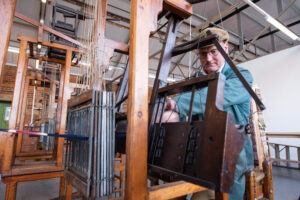
Could we bring the looms back?
I went away for our summer holidays, eager to return, and get the looms shipped over to Farsley and to start pouring over the massive 3D jigsaw puzzle.
In all, Gil and Olivia gave us about 12 looms, with the understanding that we could fulfil the dream they also had, of getting them up and running and used again.
In the autumn I started laying out all the parts to see if we could fulfil that dream. I also had a deadline; if we were to fill weaving courses in the Spring, we had to start marketing them before Christmas and equally we couldn’t market courses until we were sure that we had operable looms. Due to work commitments that meant I had about I had about 4 weeks, I would have to grab a spare hour here and there to try and at least get one running.
The looms, it transpires are over 100 years old, there is no makers mark on them, and I guess they were specially made for Leeds University. Latterly, Alice Chandler found a super picture of them in the University of Leeds Archives – a picture I could have done with to help restore them!
Missing parts
The first job was to get a joiner to repair the amputated loom frames. Meanwhile I set to work on the old dobbies (the dobby is the mechanism of springs, wires and levers that allows the weaver to control the pattern in the loom). It quickly became apparent that I could never get all 12 running again, nor did we have the space, but by swopping parts between looms I could get maybe 8 or even 10 going. I was making steady progress, loom after loom was re-emerging from the heap of parts and being built up in the newly restored Mill building that we had decided would be their new home. I was so focused on the looms that it wasn’t until I nearly finished and turned my thoughts to weaving that I realised we were missing a vital part – there were no pirns.
A pirn is the little bobbin that sits inside the shuttle with the weft yarn wound around it. Without a pirn the shuttles were useless and the looms were seriously compromised, it would be a bit like have a motor bike, but having to push it along rather than fire up the engine. Now, the looms were made over a hundred years ago by an unknown maker, but at least the shuttles had a name on them; “Jowitt of Shipley”, but they had long gone too, so the only solution was to make some new pirns. There were two problems, firstly I needed to find a woodturner and secondly I needed a pirn as a pattern for the woodturner to work from. On a dark wet November night at the Farsley Lights celebration I came across Ian Davenport. Ian is a fascinating guy, who is now a full time woodturner, and he was sure that he could help us make the pirns. With the lack of a pattern I resorted to drawing a couple of sketches of what I thought the pirns might have looked like. Ian soon came up with a prototype, which only needed tweaking before he was able to go into full scale production for the next two weeks and turnout 100 pirns. I think Ian took about 7 or 8 minutes to make the first pirns, but had it down to 3 minutes by the time he was finished!
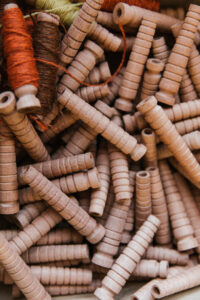
Teamwork
Meanwhile I set up eight of the looms and Agnis started the long process of re-cording them all, and making warps for each one. With the help of Sonia Moran, she was able to draw each warp into the looms, threading each warp thread or end through the heald shafts which are controlled by the dooby and help form the weave, and then through the sley or reed which beats up each weft thread or pick after it is inserted by the shuttle. Finally, after 2 months of hard work the looms were ready to trial.
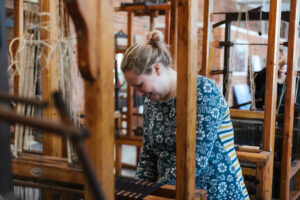
Yarn
Now we needed to source a nice range of yarns. In the days that we were a commercial mill we had specialised in fine worsted suiting cloth, which the handlooms would be perfectly capable of weaving, but given the fact that we would be using them to train novice weavers and the fact the looms were only ¼ width, it made much more sense to use the chunkier, stronger woollen yarn, Woollen spun yarn is easier and more forgiving to work with and it also produces a more versatile fabric. So being a “worsted man”, I didn’t have any connections with our the sister trade of the “woollen” business. Thankfully more woollen spinners have survived in the UK than worsted spinners, so after a few phone calls, I had ordered sample yarn cards and they were their way to Sunny Bank Mills. There are some lovely stock supported yarns still being spun in and around Yorkshire, and in the end Agnis and I were spoilt for choice as we poured over the sample cards and tried to reduce our choice of yarns down to 10-12 shades.
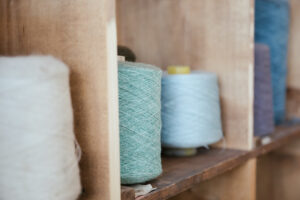
shuttles
First Agnis started weaving with a quill shuttle, thus avoiding the complication of the flying shuttle. The quill shuttle is passed through by hand, so although slower, it takes out a lot of the complications that a shuttle brings. We were now able to work through any remaining dobby problems, set the heights of the beaters, which hold the sley, and check the let-offs, which keep the warp threads tight, were all working. Once these parts had been addressed we were able to introduce the flying shuttles and align all the shuttle boxes and picking mechanisms, this is the part that flings the shuttle across from one side of the loom to the other. It was a wonderful week as all the looms gradually came back to life. Agnis was continually adjusting and tweaking the settings, each time improving the performance of the 100 year old looms. The shuttles flying across the race boards, clicking and clacking; the looms frames gently creaking with the motion of the weaver and the rattle of the ratchets as the warps were let-off and taken up.
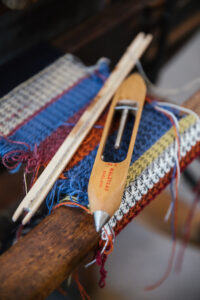
Guinea pig students!
Inevitably, true to Murphy’s Law, the task took the time allotted to it and we had enough looms up and running just in time for a practice day with our wonderful Archive volunteers acting as class of “guinea pig” students for Agnis to trial the looms and iron out any problems before her weaving classes went live. It was time well spent, and we learnt that people come in all shapes and sizes, so the looms needed to be more adjustable and despite all the fettling we had done, the first time weavers were still encountering too many teething problems to really get going. So Agnis and I went back through all the looms yet again, more adjustments, or “tuning” as it is known in weaving circles, altering the shed geometry and weaving positions.
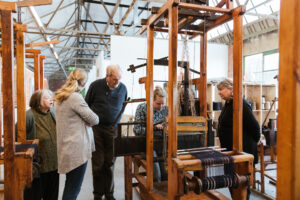
Result – satisfaction!
So, when we finally welcomed the first class of weavers, 6 months after the looms had first arrived, the looms looked splendid, much as they had done when they were part of the serried ranks in the University weaving shed all those decades before. The frames all oiled and gleaming, the warps all beautifully prepared with different drafts and peg plans to allow the students to start to explore the wonderful world of weaving.
It was so satisfying to see the looms once again brought back to life and being used for the purpose that they were first intended, and to see the delight on the faces of the weavers as they started to create their own cloth for the first time. The skills of weaving will not now be lost in this famous wool village and it is with great pride that the next generation of weavers absorb this ancient craft.
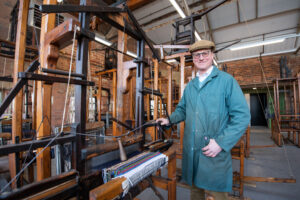
Find out more about our weaving courses and the history of Sunny Bank Mills.
Back To Blog Next (MA History Placement) Prev (Ones to Watch Artist Interviews: Lucy Clayton)
Tags
Museum & Archive Arts & Culture Regeneration General
